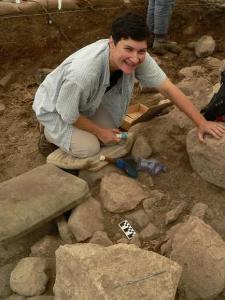Nov 18 2010
The ability to tell the difference between crystals that formed naturally and those formed by human activity can be important to archaeologists in the field.
This can be a crucial bit of information in determining the ancient activities that took place at a site, yet archaeologists often wait for months for the results of laboratory tests.
 This is Kristin Poduska of Duke University.
This is Kristin Poduska of Duke University.
Now, however, an international team of physicists, archaeologists and materials scientists has developed a process that can tell in a matter of minutes the origin of samples thousands of years old. The new device is easily portable and works by "lifting off" the spectral fingerprint of a material with infrared light.
The first material tested was the mineral calcite, commonly found in rocks such as limestone, which forms over millions years in sediments. These rocks can also contain the mineralized shells of sea creatures. Archaeological sites may also feature calcite that was a part of ash, plaster, or other building materials.
In the latest issue of the journal Advanced Materials, on-line today, Stefano Curtarolo, associate professor of mechanical engineering and materials sciences and physics at Duke University, and Kristin Poduska, associate professor of physics at Memorial University in Newfoundland, and their colleagues at the Weizmann Institute of Science in Israel, describe the new approach, which has already been successfully tested in archeological sites in Israel.
"The key to determining a sample's origin lay in figuring out how well the crystal structure is organized," Curtarolo said. "Naturally occurring calcite crystals are tightly organized, while a material created by humans from calcite is usually far less organized."
However, interpreting the information obtained using traditional methods is time-consuming and tricky, since such factors as particle size and the alignment of the atoms within the crystals can send out conflicting information.
"For this reason, getting useful and reliable information about the sample usually requires careful and time-intensive sample preparation with highly specialized equipment," Poduska said.
The researchers used infrared spectroscopy to take advantage of the fact that different molecular units absorb light differently, yielding distinct spectral peaks, or molecular fingerprints. They put a sample through a series of grindings – sometimes as many as a dozen – while taking detailed infrared spectroscopy readings after each one. By analyzing the absorption peaks at different points in the grinding process, as the particles got smaller and smaller, they could tease out the effects of size and organization.
For example, Curtarolo said, an archaeologist finds a sample and knows that it is calcite, but what cannot be determined at the site is whether it is a naturally occurring mineral, or a building material made of calcite. Plaster is made by heating limestone, grinding it up and mixing it with water.
"We've shown in the field that our method can quickly detect subtle differences in the organization of a crystal by decoupling the two factors that influence the spectral peaks," Poduska said. "Our method is particularly powerful because the direct measurement of particle size is not needed, and it can be used with any crystal that can be excited by infrared light."
Last summer, a team of archaeologists and scientists from the Weizmann Institute successfully tested the new approach at an ancient site in central Israel at Tel Safit, close to where David is thought to have slain Goliath.
"Whenever they found something white, they would call us over to do tests," Poduska said. "We were able to confirm whether the sample was rock or plaster, which helps us decide how to proceed at the excavation site."